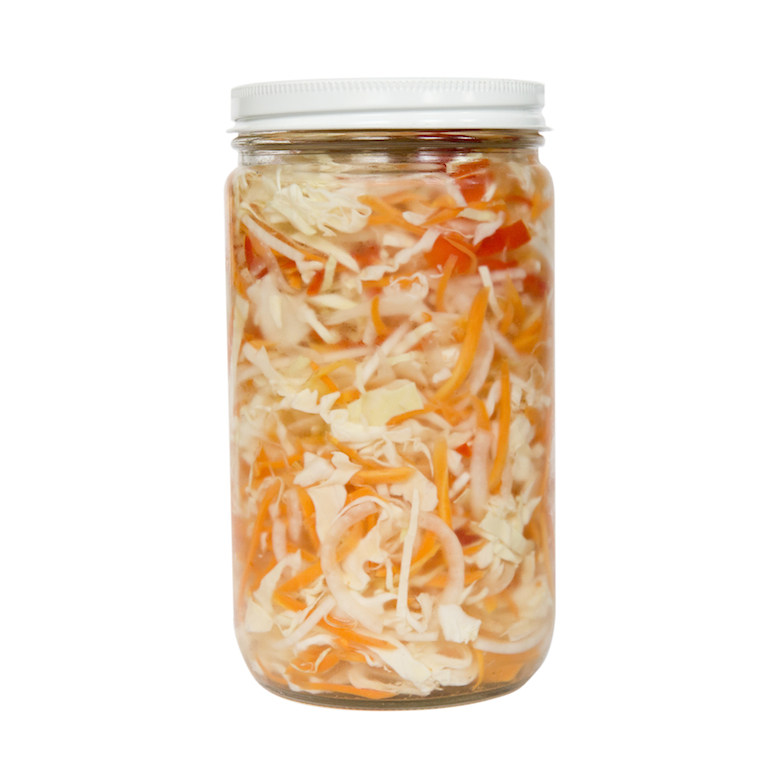Years ago I ate at a waterfront fish shack in Grand Cayman known for its fry bread and conch. The most memorable part of my meal didn’t come from the sea, however, but the old Sanka Instant Coffee container sitting on my table. It was filled with pikliz — shredded cabbage, carrots, white onion and Scotch bonnet peppers, all marinating in copious quantities of plain white vinegar. Made by the restaurant’s Haitian cook, it was a mess of spicy sweet heat — and I nearly emptied the jar.
I’ve been making pikliz at home in Brooklyn ever since, and I’m not alone. Our borough is home to one of the largest populations of Haitians outside the Caribbean, and likely all of them, says Nadege Fleurimond, a Haitian-American caterer and chef from East Flatbush, have pikliz in the fridge.
Pikliz (it’s pronounced PEEkleez) is Haiti’s all-purpose condiment — it’s hot sauce, but also its coleslaw and kraut. You use its crunch and tang to tame fritay, which can be griot (pork fried in its own fat), tassot (fried beef) or even banan peze (pressed and fried sweet plantains).
Or if you’re eating a bowl of soup or rice and beans, says Fleurimond, you simply “drizzle in the liquid.” At any meal and at every table, she says, “pikliz is always there, of course.”
Fleurimond, a Columbia University graduate who recently traveled through her native country to study its regional food culture, likes to call cabbage “the queen of the dish.” To my mind, though, it is just as likely those tropical, floral peppers.
In Haitian Kreyòl, or Creole, they are known simply as piment la kay, says Winnie Lamour, a Cornell-trained language expert in Canarsie who runs the Haitian Creole Language Institute of New York. “Piment” means pepper or chili, she explains, and “la kay” means home — in this case, Haiti. Kreyòl is a blend of 18th-century French from Caribbean colonizers and the languages spoken by African slaves and a little Portuguese, Spanish and Taíno Indian. Pikliz itself, adds Lamour, is based on the French word piquer, to sting.
“Haitians tend to eat spicy food,” says Fleurimond, who also notes that when you don’t have much money, a hot-pepper-laden bowl of cabbage keeps bellies feeling full. In Haiti cabbage is easily grown at home, along with their primary pikliz pickling agent, most often a mix of water and sour orange juice procured from the trees growing in every front yard.
“Vinegar is mainly a here thing,” explains Fleurimond of Brooklyn’s Haitian cooks, “because that’s something you have to buy.”
Sour oranges — found in West Indian markets here in Brooklyn, often right beside the Scotch bonnets — lead to a pikliz with a less-tart brine but a more sour flavor. Though if you do as many Haitians do, says Fleurimond, and add a boost of MSG-derived flavor with a cube of Maggi-brand bouillon or a sprinkle of Adobo seasoning powder, you might not be able to taste it.
Fleurimond is a pikliz purist, down to the repurposed glass vessels she keeps it in. It’s actually one of Haiti’s ongoing cultural jokes, she admits: “Nothing that you find in a jar,” she says, “is ever the actual item.”
Haitian Pikliz
Makes 2 cups, or 1 16-ounce glass jar
From Nadege Fleurimond, who recommends that you do as Haitians do and make this condiment the way you prefer it. While most cooks cut their vegetables thin as for coleslaw (use a mandoline if you have one), you can chop or roughly cut your vegetables or even shred them on a box grater. Also feel free to add more carrot, less hot pepper or a pinch of salt, garlic or onion powder. You can also let your pikliz marinate for days, or you can serve it after a few hours. “It depends on you,” says Fleurimond.
Note: You can find both Scotch bonnet chilies and sour oranges at Mango King market at 1126 Flatbush Avenue.
• 1 cup thinly sliced or shredded green cabbage
• 1⁄8 cup thinly sliced or shredded white onion
• 1⁄8 cup shredded carrot
• 1 Scotch bonnet pepper, stem removed and minced
• 2 cups white vinegar or 1 cup sour orange juice (from about a dozen oranges) plus 1 cup water
1. In a large stainless-steel bowl, combine cabbage, onion, carrot and hot pepper and mix them well.
2. Put the vegetables into a 16-ounce jar, cover them with white vinegar or equal parts sour orange juice and water. For best flavor, marinate for at least a few hours before serving. Pikliz will last for at least 2 weeks, refrigerated.
In November, Nadege Fleurimond will release a cookbook called Haiti Uncovered: A Regional Adventure Into the Art of Haitian Cuisine. Look for it here. Want to try more Haitian food? Find five recommendations for where to eat here.
Photo credit: John Taggart




